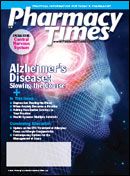Hair Loss Products
Two thirds of men in the United States will experience some degree of hair loss by age 35; pharmacists play an important counseling role in assisting patients with self-treatment.
Ms. Terrie is a clinical pharmacy writerbased in Haymarket, Virginia.
Androgenetic alopecia (commonlyknown as pattern hereditary hair loss)is the most common type of hair loss,affecting an estimated one third of allmen and one sixth of women in theUnited States.1 Dihydrotestosteroneplays a key role in this androgen-dependenthereditary disorder.2 The conditioncan start at any age, but an estimatedtwo thirds of men will experience somedegree of hair loss by age 35; it is estimatedthat 85% of men will experiencesignificant thinning of the hair by age50.3 As many as 13% of premenopausalwomen report some degree of androgeneticalopecia, and the incidence mayincrease significantly in women aftermenopause.4
Hair loss also can be nonhereditary.Causes of nonhereditary hair lossinclude acute or chronic illness, useof certain medications, trauma, dietarychanges, endocrine disorders, and hormonalchanges during or following apregnancy.1 Currently, androgenetic alopeciais the only type of hair loss thatis effectively treated by OTC hair lossproducts.1
Among men experiencing androgeneticalopecia, hair loss often beginsat the temples and crowns. Some menexperience partial or complete baldness.1 Common symptoms for womenare thinning of the hair at the front ofthe hair line, as well as the sides orcrown.1
Topical Therapy—Minoxidil
Hydroalcoholic topical solutions ofminoxidil 2% and extra strength 5% arethe only FDA-approved OTC productsavailable for the treatment of androgeneticalopecia.1 Minoxidil is indicatedfor the treatment of baldness at thecrown of the head in men and for thinningof hair at the frontoparietal regionin women.1 Whereas the exact mechanismof action is unknown, minoxidilappears to increase cutaneous bloodflow directly to the hair follicles, whichthen increase in size after treatment. Inaddition, minoxidil promotes and maintainsvascularization of hair follicles inalopecia.1,4,5 Some individuals with othertypes of hair loss, such as alopecia areata,have reported some success with theuse of these products.1 Patients withsudden hair loss or nonpattern hair lossalways should be encouraged to seekmedical advice before using minoxidil.Table 1 provides examples of thosesymptoms for which self-treatment isnot advised.
Table 1
When Self-Treatment Is NotAdvised
- Sudden or patchy loss of hair
- Any signs of scalp infection or inflammation
- Women who are pregnant or breastfeeding
- Hair loss due to illness, use of certain pharmacologic agents, dietary changes, etc
- Hair loss with no known familial history of hair loss
- Hair loss due to postpartum effects
- Women with hair loss should be referred to their primary health care provider to rule out possible causes.
Adapted from reference 1.
Topical minoxidil 2% can be used inboth men and women, but the use of5% topical minoxidil is indicated formen only.1 The use of 5% minoxidil bywomen is contraindicated due to anincreased risk of facial hair growth.1 Noknown drug interactions are associatedwith the use of topical minoxidil. It isimportant to note that the concurrentuse of minoxidil with guanethidine mayenhance the incidence of orthostatichypotension, and concurrent use of oralminoxidil may increase systemic concentrationsand potentiate its effects.1,4
Because minoxidil is absorbed throughthe skin in low concentrations, the incidenceof systemic adverse effects arerare. The most common adverse effectsassociated with the long-term use oftopical minoxidil are transient hypertrichosisand local itching or irritation.1,2Minoxidil should only be used by individuals18 years and older. Table 2lists examples of OTC topical minoxidilproducts.
Table 2
Examples of OTC TopicalMinoxidil Products
Brand Name (Manufacturer)
Minoxidil 5%
- Rogaine Men's Easy-To-Use Foam (McNeil-PPC Inc)
- Men's Rogaine Extra Strength Hair Regrowth Treatment (McNeil-PPC Inc)
- Avacor Physicians Topical Formulation Hair Regrowth Treatment for Men (Keratin Solutions Inc)
- Spectral DNC Hair Loss Treatment (DS Laboratories)
Minoxidil 2%
- Women's Rogaine Hair Regrowth Treatment (McNeil-PPC Inc)
- Avacor Physicians Topical Formulation Hair Regrowth Treatment for Women (Keratin Solutions Inc)
Adapted from references 1,5.
Conclusion
Pharmacists can assist patients experiencinghair loss by reviewing medicationprofiles and identifying thosepharmacologic agents that may be associatedwith increased risk of hair loss.Prior to recommending the use of topicalminoxidil products, it is important todetermine if self-treatment is appropriateand if the cause of the hair loss hasbeen identified. Patients always shouldbe referred to their primary care physician for further evaluation if the causeof hair loss is unknown or sudden. It isimportant for women who experiencehair loss to be evaluated by their primarycare physician to ascertain possiblecauses or contributing factors.1
Patients must be counseled on thecorrect use of minoxidil, as well as theimportance of adhering to continuoususe of the product to maintain regrowthof hair.1,3 Continuing topical treatment isnecessary indefinitely, because discontinuationof treatment produces a rapidreversion to the pretreatment baldingpattern.1,4 Patients should be advisednot to apply the product more thantwice a day and not to apply to damagedor inflamed areas of the skin.1 The productalso should not be applied 24 hoursbefore or after the use of hair color,relaxer, or permanent.1 In addition, pharmacistsshould inform patients that theproduct may not be effective for everyoneand that it is a suppressive therapyand not a cure.1,3 Patients also shouldbe informed that if no sign of new hairgrowth is apparent 4 to 6 months afterinitiation of therapy, then use of theproduct should be discontinued, andconsultation with the primary healthcare provider is recommended.1
References
- Hogue, M. Hair Loss. In: Berardi R, Newton G, McDermott JH, et al, eds. Handbook of Nonprescription Drugs. 15th ed. Washington, DC: American Pharmacists Association; 2006:941-951.
- Alopecia. Merck Manuals Online Library for Healthcare Professionals Web site. www.merck.com/mmpe/sec10/ch124/ch124b.html?qt=minoxidil&alt=sh#sec10-ch124-ch124b-975. Accessed January 1, 2009
- Male Pattern Baldness: What You Should Know. Rogaine Web site. www.rogaine.com/men/inside-hair-loss/hair-loss-facts. Accessed January 1, 2009.
- Feinstein, RP. Androgenetic Alopecia: Treatment and Medication. Medscape Web site. emedicine.medscape.com/article/1070167-treatment.Accessed January 1, 2009
- Rogaine Product Information. Rogaine Web site. www.rogaine.com. Accessed January 1, 2009.

